
Cape Town is the legislative capital of South Africa. It is the country's oldest city and the seat of the Parliament of South Africa. It is the country's second-largest city, after Johannesburg, and the largest in the Western Cape. The city is part of the City of Cape Town metropolitan municipality.
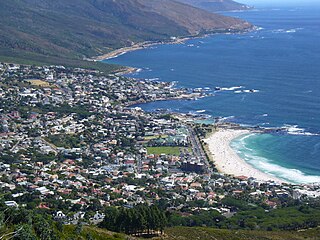
Camps Bay is an affluent suburb of Cape Town, South Africa, and the small bay on the west coast of the Cape Peninsula after which it is named. In summer it attracts many South African and foreign visitors.

Glenhazel is a suburb of the Municipality of Johannesburg, South Africa. It is located in Region E, bordering Fairmount, Sandringham, Lyndhurst and Percelia Estate. The area lies on a sloping hill with a park in the valley. It is known for its large Jewish population as well as for being home to the largest Jewish kosher hub in Johannesburg, which attracts many Jewish tourists.
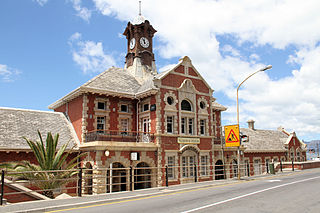
Muizenberg is a beach-side town in the Western Cape, South Africa. It is situated where the shore of the Cape Peninsula curves round to the east on the False Bay coast. It is considered to be the main surfing spot in Cape Town and is currently home to a surfing community, centered on the popular 'Surfer's Corner'.

Vredehoek is a residential suburb of Cape Town, South Africa, located at the foot of Table Mountain and Devil's Peak. It is sandwiched between the two neighbouring suburbs of Oranjezicht and Devil's Peak Estate, the latter of which is often considered a sub-suburb of Vredehoek as they both fall under the neighbourhood watch community called DPV - Devil's Peak & Vredehoek.

David Shlomo Rosen KSG CBE is an English-Israeli rabbi and interfaith peacemaker. He was Chief Rabbi of Ireland (1979–1985) before relocating permanently to Israel in 1985. He currently serves as the American Jewish Committee's International Director of Interreligious Affairs. From 2005 until 2009 he headed the International Jewish Committee for Inter-religious Consultations (IJCIC), the broad-based coalition of Jewish organizations and denominations that represents World Jewry in its relations with other world religions.
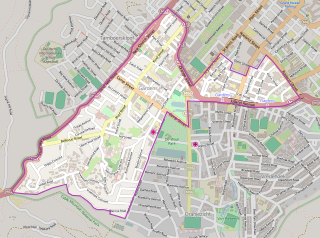
Gardens is an affluent inner-city suburb of Cape Town located just to the south of the city centre located in the higher elevations of the "City Bowl" and directly beneath Table Mountain and Lion's Head. It is home to several national museums such as Iziko South African National Gallery and the Iziko South African Museum. The University of Cape Town also houses its Fine Arts department in the suburb, at Michaelis School of Fine Art. Company's Garden, South Africa's oldest garden, a public park and heritage site is a focal point of the suburb. The area is also home to the oldest synagogue in Southern Africa, the Old Shul and its successor, the Gardens Shul, "The Mother Synagogue of South Africa."

Green Point is an affluent suburb on the Atlantic Seaboard of Cape Town, South Africa located to the north west of the central business district. It is home to Cape Town Stadium, a major sporting venue that was built for the 2010 FIFA World Cup. Sea Point promenade runs through the suburb, connecting it to Three Anchor Bay and Sea Point, a popular Jewish neighbourhood. Somerset Road forms the main thoroughfare lined by restaurants, cafés, delis, boutiques and nightclubs.
The Yeshiva of Cape Town is a kollel and yeshiva established in 1994. Its full title is "The Rabbi Cyril and Ann Harris Yeshiva of Cape Town", named for the late Chief Rabbi. It is based in the Green and Sea Point Hebrew Congregation, in the suburb of Sea Point, Cape Town.

Mouille Point ("Mu-lee") is an affluent suburb of Cape Town, situated between the Victoria and Alfred Waterfront and Granger Bay to the east, Green Point to the south and the Atlantic Ocean to the north and west. The suburb hugs the coastline and is dominated by high-end apartment blocks.

The Gardens Shul, formally, the Cape Town Hebrew Congregation (CTHC) is a Modern Orthodox synagogue located in the Company Gardens, in the Gardens neighborhood of Cape Town. It has the oldest Jewish congregation in South Africa, dating to 1841. The congregation, known as "The Mother Synagogue of South Africa," possesses two historic structures, the 1863 synagogue known as the Old Shul and the 1905 synagogue. The South African Jewish Museum, located in its grounds, also occupies the Old Shul and is responsible for its upkeep. The 1905 building is an example of Edwardian architecture and has been called "one of the most magnificent synagogues in the world."

St James is a seaside village on the Cape Peninsula, South Africa, situated on the False Bay coast between Muizenberg and Kalk Bay. The village is situated between the rocky shore and a steep mountain, and measures about 200m by 2 km. Its name derives from the early St James Catholic Church, built circa 1880. Most of the suburb was built between 1910 and 1950, after the railway line was built connecting Cape Town to False Bay.

Herolds Bay is a beach resort on the Southern Cape coast. It is 6.4 km from George Airport and can be reached by the R404.
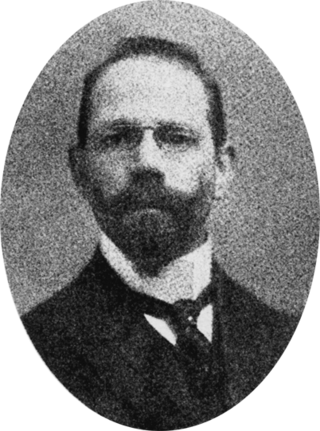
Sir Jacobus Arnoldus Combrinck Graaff, also known as 'Sir James', was a South African cabinet minister, Senator, businessman, and South African Party whip.

The following outline is provided as an overview of and topical guide to Cape Town:

The South African Union for Progressive Judaism (SAUPJ) is an affiliate of the World Union for Progressive Judaism and supports 11 progressive congregations. Rabbi Moses Cyrus Weiler, a founder of Reform Judaism in the country, led the country's first Reform synagogue, Temple Israel in Hillbrow, Johannesburg. Weiler is credited with growing the movement, to represent 15-17% of South African Jewry and establishing 25 congregations in the country. A 2020 joint study by the Institute for Jewish Policy Research and the University of Cape Town showed that 12% of Jews identified as Progressive and that in relative terms the progressive strands are increasing after falling to 7% in 1998 and 2005 studies. In Johannesburg, the community accounts for 7% of the city's Jewry, rising to 18% in Cape Town and 25% in Durban.
Temple Israel, also known as the Cape Town Progressive Jewish Congregation (CTPJC), is a Progressive Jewish congregation in Cape Town, with three centres in Green Point, Wynberg and Milnerton. As three centres combined, they are the largest Progressive congregation in South Africa, and the second largest Jewish congregation in Cape Town after Marais Road Shul in Sea Point. The congregation first started in Green Point in 1944, eight years after South Africa's first progressive synagogue, also Temple Israel, opened in Hillbrow in Johannesburg. The Cape Town congregation caters to over 3000 Progressive Jews in the city. The congregation is an affiliate of the South African Union for Progressive Judaism, which is part of the World Union for Progressive Judaism (WUPJ). The congregation represents around 18% of Cape Town Jewry.

Graaff's Pool is a public bathing area, tidal pool and notable landmark in the Cape Town neighbourhood of Sea Point, South Africa.
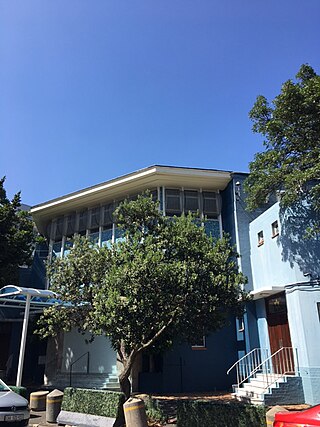
The Marais Road Shul, formally, the Green & Sea Point Hebrew Congregation (G&SPHC) is a notable Modern Orthodox synagogue in Sea Point, a seaside suburb of Cape Town. The congregation was first established in 1926, and the synagogue was completed in 1934. It had initially intended to become a branch of the Gardens Shul in the City Bowl, but opted for independence, and became the larger of the two. It is the largest Jewish congregation in South Africa, and by 1994, it had become the largest in the South Hemisphere. The Sephardi Hebrew Congregation, established in 1960, also operates a shul from the G&SPHC's Weizmann Hall on Regent Road in Sea Point.
The Beit Midrash Morasha at Arthur's Road is a Modern Orthodox synagogue in Sea Point, a seaside suburb of Cape Town, South Africa. The congregation was first established in 1897 in District Six, before relocating to Vredehoek in 1945. It moved to its present location on Arthur's Road in Sea Point in 1954.






























